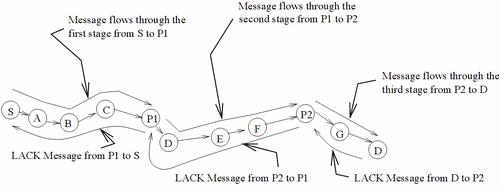Split-tcp
Split-TCP
Introduction
A protocol concept to improve Data transfer rates over mobile wireless Ad-Hoc networks. "Split-TCP" or "TCP with proxies" was developed at the University of California Riverside and describes the possibility to improve efficiency with more than 2 connections. It reduces the problems of suppression of connectivity and unnecessary efforts in finding new network routes. The protocol is understood as further development of the TCP network protocol. Generally it is a service with proxys installed in the network.
Proxys: are network nodes, a connecting piece, which receive IP-packets from Source and deliver to the destination.
current problems of TCP
The nodes devide the data bandwidth into unfair pieces. If more than one connection is established at one node, then this connection is preferred, which:
- established first
- sends more data packets per second
- has a shorter way from source.
The effect is a suppression of the first connection, which is as long suppressed as the second one delivers packets and use the bandwidth.
How it works
The protocol lays down a proxy after a certain number of hops (network nodes).
The rules
- A packet through a hop is delivered like in a normal TCP-Packet
- A hop becomes a proxy, when the IP-Packet went through a certain number of hops
- A proxy is a proxy only for one connection. Even when it delivers IP-packet of a second connection, it behaves like a normal hop simultanously.
- A proxy sends a local acknowledgement (LACK) to the previous proxy or source.
- Another Acknowledgement (ACK) is sent from the destination to the source.
- Even the ACK needs a LACK every proxy.
the buffer
- store every data packet of every connection until it is acknowledged with LACK
- every ACK until delivered.
efficiency
It was shown, that an improvement of 10% to 20% data transfer rate is possible. This number varies with different settings and data traffic.
The Split-TCP protocol specially improves connectivity over network with high mobility.The last proxy connected to a fast mobile nod has to handle the situation, not the source far away.
The fairness between TCP sessions is given by adjusting the bandwidth fastly.
reference
[1] http://www.cs.ucr.edu/~krish/splittcp.pdf, University of California, 19.9.2002
